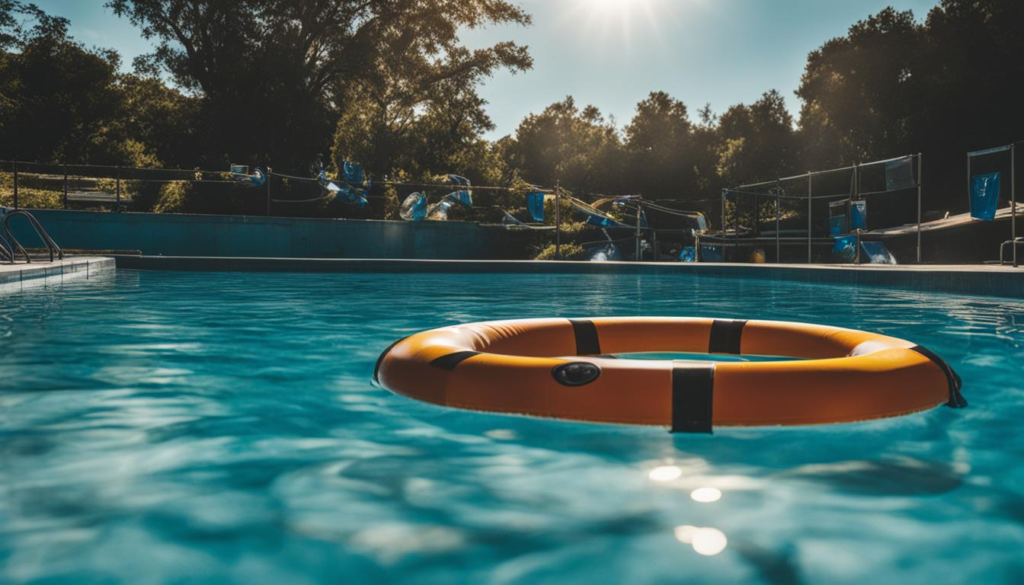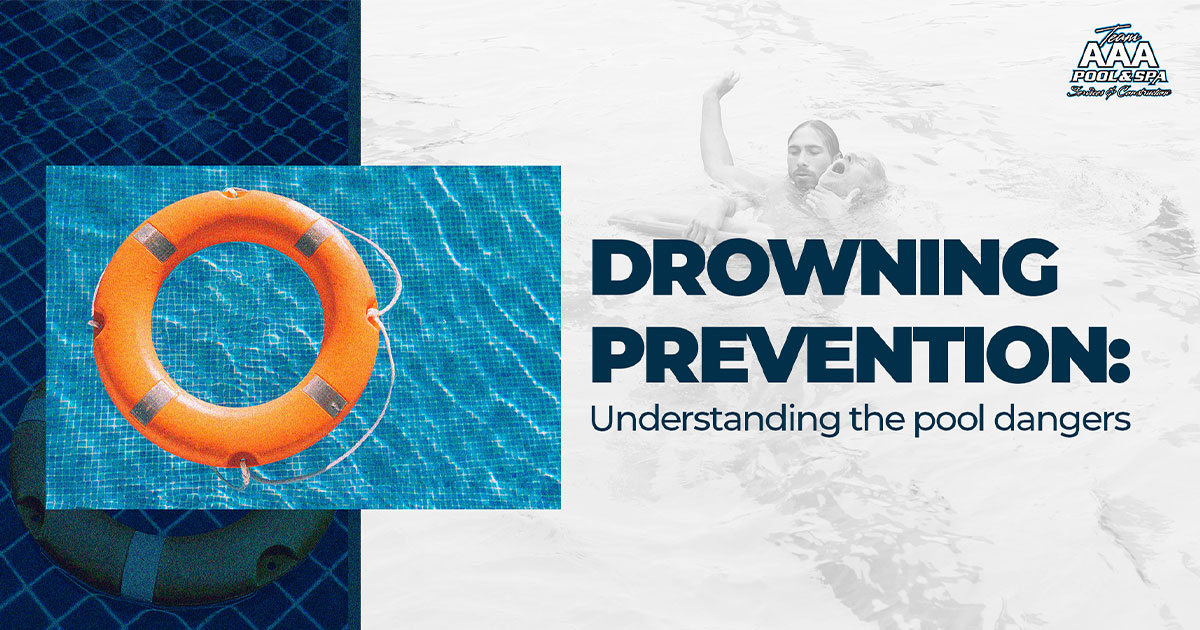When it comes to water safety, prevention is key. Whether you’re enjoying a day at the pool, swimming in open water, or participating in water activities, taking the necessary precautions can help keep you and your loved ones safe.
Swimming lessons, water safety devices, and lifeguard training are just a few of the essential tools and skills that can greatly reduce the risk of drowning. By following these water safety tips, you can ensure a safer experience in and around water.
Create an image of a calm swimmer in a pool surrounded by several layers of barriers, such as fences and pool covers, to prevent accidental access. Show floating devices nearby, with clear signage indicating the depth of the water and the importance of adult supervision for children.
Key Takeaways:
- Formal swimming lessons can greatly reduce the risk of drowning.
- Always supervise children closely when they are in or around water.
- Construct a four-sided fence around pools to prevent unsupervised access.
- Wear life jackets while boating or swimming in natural water.
- Learn CPR to save a life in case of an emergency potentially.

Teach Children Water Safety Rules and Supervise Closely
When it comes to water safety for children, close supervision is crucial. Even if your child knows how to swim, it’s important to always supervise them closely when they are in or around water. Having an adult within arm’s length of children who are not strong swimmers can help ensure their safety.
Designating an adult water watcher is a great way to ensure constant supervision and eliminate distractions. This designated adult should avoid activities like reading, texting, or consuming alcohol while supervising children around water. By maintaining their full attention on the children, they can quickly respond to any potential danger.
Teaching children the importance of water safety rules is another key aspect. Make sure your children understand the dangers of rough play and climbing on each other in the water. Additionally, it’s crucial to educate them about the signs of drowning, which can be subtle and easy to miss. Signs include floating, struggling to call for help, and treading water without progressing. By teaching your children what to look out for, they can be more vigilant and aware of their own safety.
Remember, it’s essential to supervise children closely, teach them water safety rules, and ensure their understanding of drowning signs. By doing so, you can create a safe environment for them to enjoy the water.
Encourage children who cannot swim or are weak swimmers to wear U.S. Coast Guard-approved life jackets. These life jackets provide additional buoyancy and can greatly enhance their safety in the water. It’s important to note that air-filled or foam toys should never be used as substitutes for life jackets.
While lifeguards can provide support, it’s crucial not to rely on them for supervision solely. Always choose swimming locations with lifeguards when possible, but remember that their focus is on multiple individuals, and they may be unable to provide individualized attention. Close supervision from responsible adults is still necessary to ensure children’s safety.
Teach Children Water Safety Rules and Supervise Closely
| Water Safety Rules for Children |
|---|
| Always have an adult within arm’s length when near water |
| Avoid rough play and climbing on others in the water |
| Recognize the signs of drowning: floating, struggling, treading water without making progress |
| Wear U.S. Coast Guard-approved life jackets if unable to swim or weak swimmers |
| Don’t solely rely on lifeguards for supervision |
Water Safety in Open Water and Beaches
When it comes to swimming in open water or visiting the beach, it’s important to prioritize water safety. Whether you’re a seasoned swimmer or a beginner, being aware of potential risks and following safety guidelines can help ensure a fun and safe experience.
One of the first steps to staying safe in open water is to learn how to swim. If you’re not a confident swimmer, consider taking swimming lessons to improve your skills. It’s also crucial to swim in designated areas that are supervised by qualified lifeguards. These professionals are trained to spot potential dangers and provide assistance if needed.
Before entering the water, check the water temperature and weather conditions. Avoid swimming in rain or thunderstorms, as well as staying in cold water for too long. It’s always a good idea to swim with a buddy and have someone on shore keeping a watchful eye. Remember that lifeguards are responsible for multiple people and may not be able to provide individualized supervision.
| Open Water Safety Tips | Beach Safety Tips | |
|---|---|---|
| Always Swim in Designated Areas | Swimming in designated areas with lifeguards ensures that you are swimming in safe and monitored zones. | Beach lifeguards often designate specific swimming areas with flags or buoys. Swim in these designated zones to minimize risks. |
| Be Aware of Environmental Conditions | Check for strong currents, rip tides, and other potential hazards in the open water. Swim parallel to the shore if caught in a current. | Pay attention to beach warnings, including high surf advisories and jellyfish alerts. Avoid swimming in areas with hazardous conditions. |
| Avoid Alcohol Consumption | Alcohol impairs judgment and coordination, increasing the risk of accidents in open water. Stay sober to ensure your safety. | Avoid consuming alcohol while at the beach as it can impair judgment and increase the risk of accidents in the water. |
| Wear U.S. Coast Guard-Approved Life Vests | Life vests are essential for weak swimmers or individuals participating in activities such as boating or kayaking in open water. | Young children, weak swimmers, and individuals participating in water activities should wear life vests approved by the U.S. Coast Guard. |
By following these water safety tips and guidelines, you can enjoy your time in open water and at the beach while minimizing the risk of accidents or drowning. Remember to always prioritize your safety and stay informed about the current conditions and any potential hazards.
Importance of Learning CPR and First Aid
When it comes to water safety, knowing CPR (Cardiopulmonary Resuscitation) and having first aid skills can be the difference between life and death. CPR is a life-saving technique that is used in emergencies to revive a person who has stopped breathing or whose heart has stopped. By learning CPR, you can potentially save someone’s life in the critical time it takes for paramedics to arrive.
Many organizations, such as the American Red Cross and the American Heart Association, offer CPR training courses both online and in-person. These courses provide hands-on instruction in performing CPR and teach you the necessary skills to respond to emergency situations effectively. By obtaining CPR certification, you can have the confidence and knowledge to act swiftly in life-threatening situations.
In addition to CPR, having first aid skills is crucial in handling emergencies related to drowning or water accidents. First aid training equips you with the knowledge to provide immediate care and assistance until professional medical help arrives. This can include administering basic wound care, applying bandages, stabilizing fractures, and managing shock. By having these skills, you can prevent further injury and potentially save lives.
Emergency Preparedness
Being prepared for water-related emergencies is essential. By having emergency plans and protocols in place, you can minimize panic and uncertainty during critical situations. Make sure you are familiar with the location of safety equipment, such as life rings or flotation devices, and know how to use them effectively. It is also important to clearly understand emergency contact numbers and procedures, ensuring that you can quickly and efficiently communicate with authorities if needed.
Stay Updated and Refresh Your Skills
CPR guidelines and techniques evolve over time, so it’s important to stay updated with the latest information. Regularly check for updates from reputable sources, such as the American Heart Association, to ensure that you are following the best practices in CPR. Consider refreshing your CPR and first aid skills through refresher courses or practice sessions. By staying up-to-date and maintaining your skills, you can be better prepared to handle emergencies and potentially save lives.
Remember, in water-related emergencies, every second counts. By learning CPR and first aid, you are equipping yourself with the tools and knowledge to be a lifesaver in critical situations. Invest in your own safety and the safety of others by obtaining CPR certification and acquiring essential first aid skills.
Show a person performing chest compressions on a mannequin while a group of people watch and learn in a brightly lit room. The mannequin should be placed on a flat surface, and the person performing CPR should have their hands placed correctly in the center of the chest as they press down with enough force to compress the chest by about two inches. The onlookers should be standing or sitting around the person, with some taking notes or holding equipment such as an AED or first aid kit. The scene should convey the importance of learning CPR and first aid in preventing drownings and other emergencies.
Avoiding Risks and Hazards in Water Activities
Create an image that highlights the dangers of water currents and undertows. Use contrasting colors and swirling lines to convey the chaotic and unpredictable nature of these hazards. Show a lone swimmer struggling against the strong current, with waves crashing around them and debris swirling in the water. Emphasize the need for caution and awareness when swimming in open water and the importance of knowing how to escape from a dangerous current.
When engaging in water activities, it is crucial to be aware of the risks and hazards involved and take necessary precautions to ensure your safety. By following safety guidelines and rules provided by authorities and facilities, you can enjoy water sports and recreational activities while minimizing the risk of accidents, injuries, or drowning.
Dangers of Water Hazards
Water hazards can pose significant risks to individuals participating in water activities. Some common water hazards include strong currents, underwater debris, and changes in water conditions. It is essential to stay informed about local weather conditions, water conditions, and any potential hazards before entering the water.
Table: Types of Water Hazards
| Hazard | Description |
|---|---|
| Strong Currents | Powerful currents that can pull swimmers away from shore and make it difficult to swim back. |
| Underwater Debris | Objects beneath the surface, such as rocks or fallen trees, that pose a risk of injury if swimmers come into contact with them. |
| Changes in Water Conditions | Fluctuations in water temperature, tides, or waves that can affect swimming ability and pose dangers to swimmers. |

Taking Precautions
When participating in water activities, using common sense and prioritizing personal safety over taking unnecessary risks is essential. Avoid diving or jumping into shallow water, and never swim alone in unfamiliar or hazardous areas. Educating yourself about potential health problems related to water activities, such as ear infections or waterborne illnesses, and taking preventive measures can also help ensure a safe and enjoyable experience.
Following Safety Guidelines
Always stay informed about local safety guidelines and rules for specific water activities. Pay attention to any signage or instructions provided by lifeguards or facility personnel. By adhering to these guidelines, you can minimize the risks associated with water activities and create a safer environment for yourself and others.
Conclusion
In conclusion, drowning prevention is paramount for everyone, regardless of age or swimming ability. You can stay safe in and around water by following essential water safety tips and taking necessary precautions.
First and foremost, learning to swim and participating in formal swimming lessons can significantly reduce the risk of drowning. However, even with swimming skills, close supervision is crucial, especially for children.
Additionally, open water safety and beach safety require additional awareness of environmental conditions. Always swim in designated areas, be mindful of currents and weather conditions, and never underestimate the importance of wearing U.S. Coast Guard-approved life jackets.
Lastly, being prepared for water-related emergencies is vital. Acquiring CPR and first aid skills, along with having emergency plans in place, can be instrumental in saving lives. Stay informed, stay cautious, and prioritize safety to enjoy water activities while minimizing the risk of drowning.
FAQ
How effective are formal swimming lessons in reducing the risk of drowning?
Formal swimming lessons can significantly reduce the risk of drowning. However, even children who have had swimming lessons still need close supervision when in or around water.
What safety measures should be taken in pool areas?
It is important to construct a four-sided fence around pools, at least four feet in height, with self-closing and self-latching gates. Remove toys from the pool area when not in use to prevent attracting children to the pool.
How should adults supervise children in or around water?
Always designate a responsible adult to supervise children closely and avoid distractions like reading, phone use, or consuming alcohol or drugs.
When should life jackets be worn?
Life jackets should be worn by people of all ages and swimming abilities while boating or in natural water.
Why is it important to learn CPR skills?
Learning CPR skills can potentially save a life before paramedics arrive in the event of a water-related emergency.
What hidden hazards should be aware of in natural waters?
Hidden hazards in natural waters can include currents, waves, rocks, and limited visibility. It is important to check the weather forecast before engaging in water activities.
Can alcohol consumption impair water safety?
Yes, it is advised to avoid drinking alcohol before or during swimming or water activities as it impairs judgment and coordination.
What is the importance of using the buddy system?
Using the buddy system and swimming with a friend is especially important for individuals with medical conditions or seizure disorders.
What extra precautions should be taken if a family member has a medical condition?
If you or a family member has a medical condition that increases drowning risk, it is important to take extra precautions and ensure close supervision.
What should be avoided to prevent blackout and drowning?
To prevent blackout and drowning, it is important to avoid hyperventilating or holding breath underwater for extended periods.
Should children who know how to swim still be closely supervised?
Yes, it is important to supervise children closely at all times when in or around water, even if they know how to swim. Be within arm’s length of children who are not strong swimmers.
How can rough play in the water be dangerous?
Children should be taught the dangerousness of rough play and climbing on each other in the water to prevent accidents or drowning.
What are the signs of drowning?
The signs of drowning can be subtle and include floating, treading water without making progress, struggling to call for help, and keeping the head above water to breathe.
What type of life jackets should children wear?
Children who cannot swim or are weak swimmers should wear U.S. Coast Guard-approved life jackets. Avoid using air-filled or foam toys as substitutes for life jackets.
Should lifeguards be solely relied upon for supervision?
Lifeguards should not be solely relied upon for supervision. Choose swimming locations with lifeguards when possible, but maintain close supervision regardless.
When should you leave the water?
If in doubt or if conditions change, it is best to leave the water. Trust your instincts and prioritize safety.
What precautions should be taken in open water?
Check water temperature and weather conditions before swimming. Avoid swimming in rain or thunderstorms, and don’t stay too long in cold water. Swim with a buddy and swim in designated swimming areas under the supervision of qualified lifeguards.
Is alcohol consumption safe while in the water?
It is important to avoid consuming alcohol while in the water, as it impairs judgment and coordination, increasing the risk of accidents or drowning.
Who should wear life vests?
Young children, weak swimmers, and everyone should wear U.S. Coast Guard-approved life vests in and around water.
Why is it important to learn CPR and first aid?
Learning CPR and first aid can be crucial in handling water-related emergencies and potentially saving lives before professional help arrives.
How can risks and hazards be avoided in water activities?
Avoiding risks and hazards in water activities can be achieved by staying informed, following safety guidelines, and making informed decisions. Prioritize personal safety and avoid taking unnecessary risks.
What is the conclusion for drowning prevention?
Drowning prevention is essential for everyone, regardless of age or swimming ability. By learning to swim, practicing water safety rules, and closely supervising children, the risk of drowning can be minimized. Additionally, acquiring CPR and first aid skills, as well as being aware of risks and hazards in water activities, can further contribute to staying safe in water.










